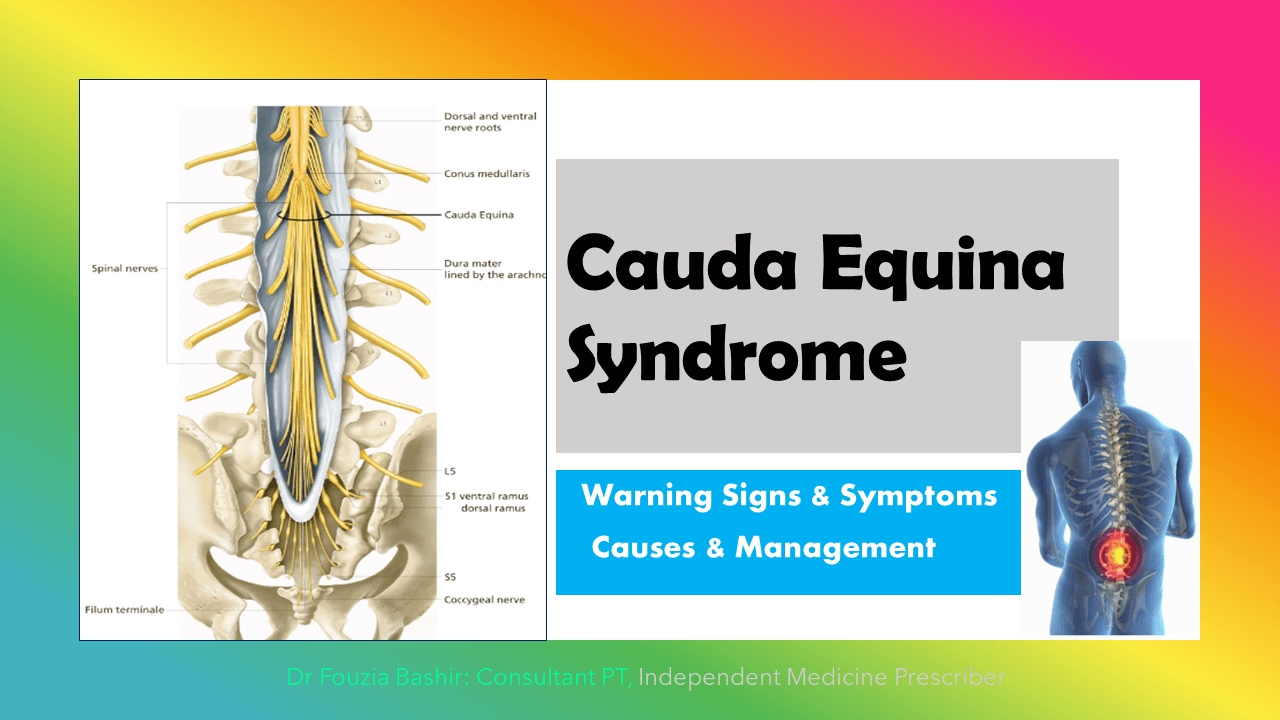
The Cauda Equina Syndrome is caused by the compression or damage of the nerves in the cauda equina. The cauda equina syndrome is a serious and rare condition that requires prompt diagnosis and management. The cauda equina syndrome could lead to disability if not managed appropriately on time.
The cauda equina is composed of bundle of nerves at the end of the spinal cord (figure 1). The cauda equina is also called as horse tail. The spinal cord end at L1 level. Below this level, a bunch of nerves combine to form cauda equina. It contains LI- L5 and S1-S5 nerve roots. The nerves of the cauda equina supply to the lower limbs, urinary bladder, bowels, skin of the genital area, and anus.

Causes of The Cauda equina Syndrome
Sign and Symptoms of the Cauda Equina Syndrome
The onset of Cauda Equina Syndrome may be sudden or gradual. The gradual onset of CES present with the above-mentioned sign and symptoms. The clinical presentation depends on the nature and extent of the damage to the Cauda Equina.
The early sign and symptoms of the cauda equina syndrome can be following: -
These signs and symptoms of the Cauda Equina Syndrome are further explained below: -
The patient may present with pain in the lower back radiating to one or both legs, numbness, and weakness of the legs. However, these symptoms also present with low back pain in the absence of Cauda Equina Syndrome.
Risk Factors
Why Early Recognition of Cauda Equina Syndrome is Important?
The Cauda Equina Syndrome can be complete or incomplete. With gradual onset and early recognition of the sign and symptoms of Cauda Equina Syndrome helps to treat patient immediately and in preventing the patient to progress to complete Cauda Equina Syndrome. Thus, preventing the long- term disability and incontinence.
Diagnosing Cauda Equina Syndrome
The Cauda Equina Syndrome is suspected based on history and physical examination of the patient.
It is confirmed by the MRI or CT scan. MRI is the gold standard in the diagnosis of the Cauda Equina Syndrome.
Treatment Of the Cauda Equina Syndrome
The Cauda Equina Syndrome is a surgical emergency and requires urgent referral to emergency or A&E.
The treatment of Cauda Equina Syndrome usually requires surgical decompression if it is caused by herniated disc. Following surgery, patient will require physiotherapy and changes in lifestyle.
If it is caused by the other underlying condition, that also needs to be treated.
Preventing the Cauda Equina Syndrome
The Cauda Equina Syndrome can be prevented if bladder and bowel dysfunction and saddle anesthesia are recognized and managed at an earlier stage.
Prognosis of the Cauda Equina Syndrome
The recovery of the Cauda Equina Syndrome depends on the nature and extent of the injury and when it was diagnosed. If damage is mild, recovery is better. Similarly, if the patient is diagnosed earlier, recovery will be better. However, if it is progressed to full Cauda Equina Syndrome, then prognosis is poor. Such cases require very long rehabilitation.
Links for further information: -
Author Information
The healthcare professionals write our blogs to provide useful information for the patients and public. The author of this blog post is: -
Dr Fouzia Bashir, PhD, MSC ACP, BSPT.
Comments List
Sania
My friend has back pain from one year. Sometimes, she felt pain moving down in her right leg. She is worried about leaking occasionally when she she cough. Does she has a cauda equina syndrome?